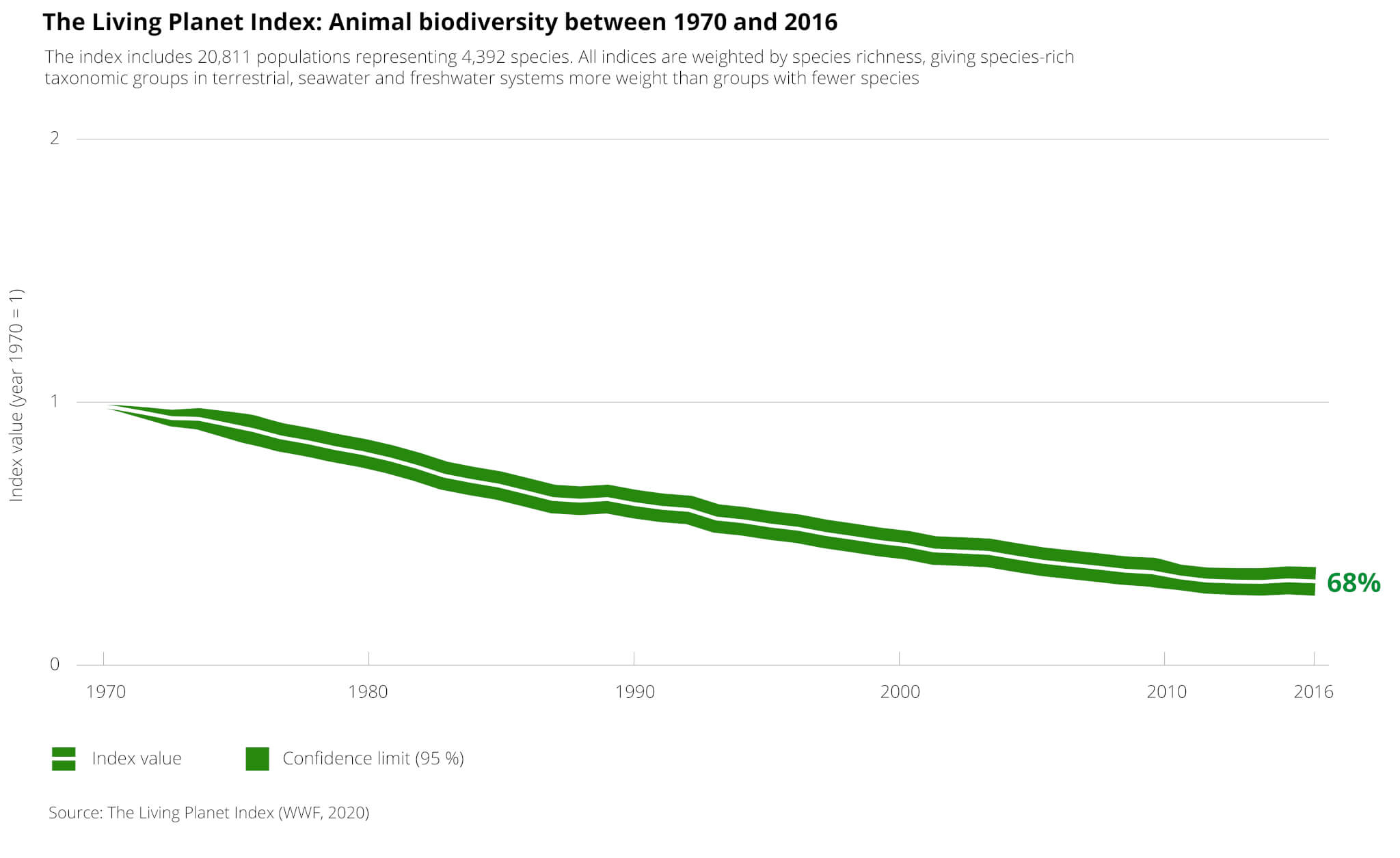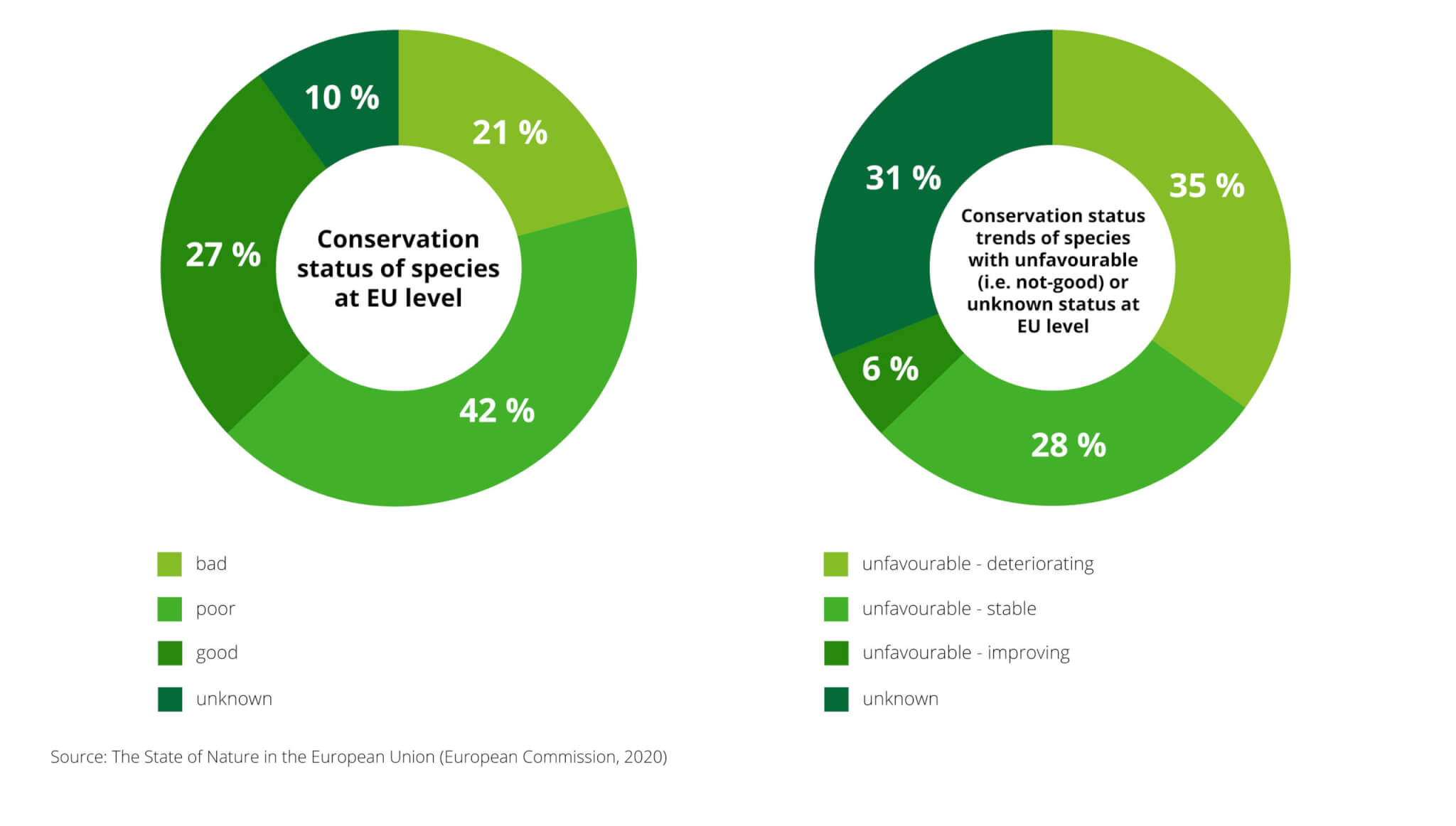Biodiversity mirrors human activity and its impacts on nature. However, the reflection is not a flattering one. According to the 2020 Living Planet Index, the population of certain animals has declined by 68% on average since 1970. Not even the European network of protected habitats and species can prevent this decline – its latest report shows that the situation of protected species is not improving. The new Global Biodiversity Outlook 5 confirms this fact, calling for comprehensive and integrated solutions. After all, biodiversity protection is in the interest of all humankind. Although the COVID-19 pandemic has temporarily improved certain areas of environment protection in Europe, especially air quality, biodiversity loss will have major negative consequences in the long run as encroachment into natural habitats increases the risk of transmission of hitherto undiscovered diseases to humans.
The global animal population is steadily declining
According to the global Living Planet Index 2020, the population sizes of mammals, birds, amphibians, reptiles and fish have experienced an unbelievable average decline of 68% between 1970 and 2016. The study identifies land and sea exploitation, including loss and degradation of natural habitats, as the biggest threat. This trend is the same on all continents, across all classes of animal and plant species. Moreover, the data have also shown a stable decline in the distribution of species across habitats and a decrease in available habitats together with decreasing intact biodiversity, proving the global effects of intense human activity in the past decades.
The situation in Europe is not improving despite strict nature protection control
The recently published Commission Report on the State of Nature in the European Union does not provide many reasons for optimism either. The report evaluates the fulfilment of goals of the Birds and Habitats Directives on which the network of protected areas Natura 2000 is based. The data show that despite a network of protected areas, the habitat and species protection situation is not improving in a significant manner and the goals set for 2020 have not been achieved. The main pressures on the habitats include, unsurprisingly, intense agriculture (intensified use of land and hydrological regime change), forestry, urbanisation and hunting.
While the Natura 2000 network has been significantly extended, the decline in species diversity and habitats has not been halted. It is necessary to improve protective measures and monitoring in many areas. In general, it is necessary to make necessary investments in nature, include biodiversity protection into national policies and strategies and implement sustainable procedures in the area of land and water use.
It will not be easy to bend the biodiversity decline curve
The new Global Biodiversity Outlook 5 shows that protection alone is not enough, proving that the global biodiversity protection goals were not met in 2020. However, it is not too late to “bend the curve“ of biodiversity decline. The inevitable solutions will be comprehensive and require a significant departure from the existing practice. A sustainable transition must be achieved in the use of land and forests, fishing and ocean management, agriculture, water management, food systems, cities and infrastructure and in response to climate changes. Only then will it be possible to meet the Vision 2050. It will not be enough to succeed in one area. An integrated and unified ecosystem requires action on all levels, as individual measures are complementary. Integrated and system measures are thus needed to bend the biodiversity loss curve.
Impacts of COVID-19 on the environment in Europe
COVID-19 has fundamentally affected the functioning of all humankind. However, today we can
already see short-term impacts of the pandemic and implemented measures on the environment. The European Environment Agency summarises the most significant impacts in Europe. The positive news is the decrease of greenhouse gases, even though it is probably only temporary and not sufficient to meet the defined commitments. Another improvement is in air quality, especially in cities. Nitrogen dioxide and particulate matter levels have dropped across Member States due to lockdowns. Spain reports the biggest pollution decrease by 60% and 30%, respectively. On the other hand, a negative impact is the increase of reliance on disposable plastics, especially due to restaurants depending on delivery.
Unsustainable human activity will increase the risk of another pandemic
Up to 70% of new diseases (such as Ebola or Zika) and almost all known pandemics (HIV/AIDS, COVID or influenza) are zoonoses – caused by microbes of animal origin. According to the biodiversity and pandemics workshop report by the UN Intergovernmental Science-Policy Platform on Biodiversity and Ecosystem (IBPES), it is estimated that there are up to 830,000 viruses undiscovered to date that have the potential to infect humans. The risks of pandemics then increase due to human activity, especially unsustainable land use, agricultural expansion, trade and wildlife consumption. The land use change has led to discovery of more than 30% of new diseases since 1960.
Unsustainable land use, destruction of natural habitats and interventions in biodiversity lead to new pathways through which pathogens can reach farm animals or humans. The current anti-pandemic strategies focus almost exclusively on post-disease response. However, it turns out that preventive global strategies that can predict and limit the emergence of new pandemics are necessary. The costs of such solutions are then much cheaper than the economic impacts of a global pandemic.



